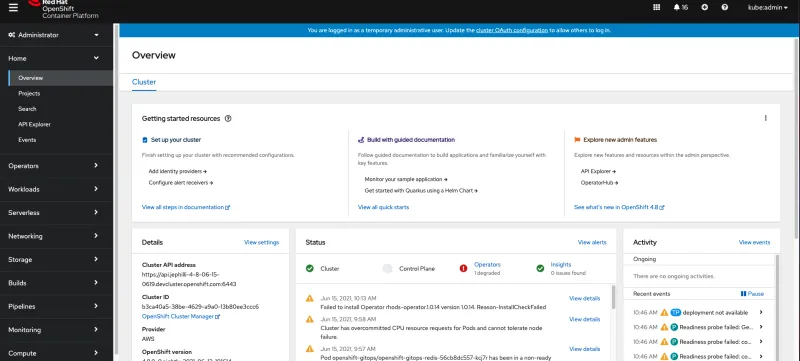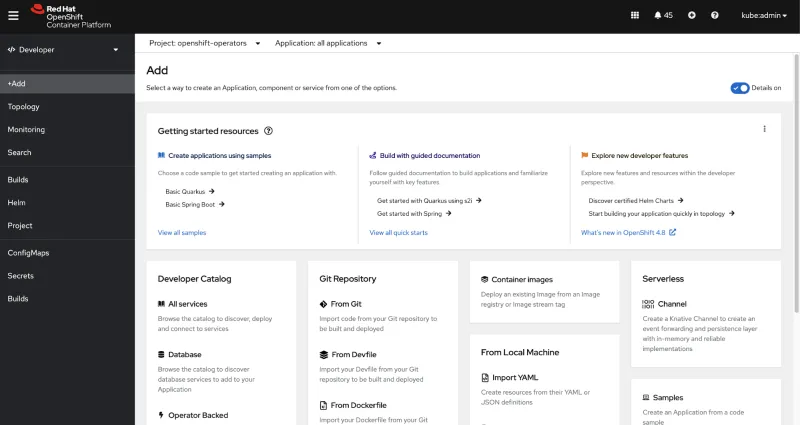Throughout 2020 and 2021, the OpenShift team held a number of Customer Empathy Workshops to collect important insights from users, like you, around pain points they encounter when using the console. The OpenShift Troubleshooting Workshop was especially important as it highlighted a part of the product experience that we had not fully fleshed out: “Getting Started.” Customers pointed out that OpenShift includes installation challenges, making it difficult to get started setting up new features. They also noted that the steep learning curve makes it difficult for new users with a lack of Kubernetes knowledge to use the UI efficiently. Lastly, they highlighted the importance of dependencies and being able to resolve a single parent resource that would update related resources. With the addition of quick starts in OpenShift 4.6, we were able to begin solving some of these issues, helping you get started with guided tutorials. Quick starts have evolved since and play an extremely important role in the newest getting started feature added to OpenShift 4.8.
Getting Started Resources
The new getting started card builds on the quick starts card that lived on the Cluster Overview and Add page, which was released in OpenShift 4.7. It includes various resources for you to get up and running with OpenShift, from the moment you land in the console. Depending on the perspective and the user’s permissions, the content of the card will change, ensuring the material directly relates to your experience.
Getting Started Resources for Developers
Developers can quickly get started creating applications by using featured samples, including the Quarkus and Spring Boot samples, or by choosing a different one from our samples catalog (see No. 1 below). Quick starts are easily available as well to help developers learn more about Kubernetes and get up and running with step-by-step instructions and tasks (see No. 2). Lastly, you will be more in-tune with the newly released features in the developer perspective, including Helm Charts and quick search in topology, as well as the rest of the new features in the what’s new in OpenShift blog (see No. 3):

Getting Started Resources for Admins
Admins can now start with a list of setup instructions to get the most out of their cluster by referencing the items in the Set up your cluster section (No. 1 below). These steps will remain only if they have not been completed, and once they have been completed, the column will be removed. Quick starts are, again, a focal point for admins to be able to reference documentation within the console rather than having to exit the UI (No. 2). They will also be up to date with the newest features in the admin perspective, including the API Explorer and console customizations, as well as the rest of the new features in the what’s new in OpenShift updates (No. 3):

How the Card Works


Each column of the card acts as an actionable sector to help you get started, and some are even dynamically updated depending on what has already been configured and completed in the cluster. By adding this dynamic functionality, we are able to provide the most helpful resources to you, whether you are coming into the console for the first time or not. The card can be removed from the dashboard by selecting more options in the menu and then Hide from view.

The card can also be brought back to the dashboard by clicking the label that will appear in the page header. If you do not want to ever bring back the card, you can remove the label by clicking the X.

Summary and Next Steps
With the help of getting started resources, we hope to enrich the OpenShift experience for you, whether you are a novice or expert. We will continue to iterate and add to the getting started experience in the coming releases, and we would appreciate any feedback. If you are interested in sharing your feedback about the getting started card, sign up to participate in our research study. You can also sign up for feedback sessions to share your input on current OpenShift features and new designs.
Sobre o autor
Mais como este
Key considerations for 2026 planning: Insights from IDC
Red Hat and Sylva unify the future for telco cloud
Edge computing covered and diced | Technically Speaking
Navegue por canal
Automação
Últimas novidades em automação de TI para empresas de tecnologia, equipes e ambientes
Inteligência artificial
Descubra as atualizações nas plataformas que proporcionam aos clientes executar suas cargas de trabalho de IA em qualquer ambiente
Nuvem híbrida aberta
Veja como construímos um futuro mais flexível com a nuvem híbrida
Segurança
Veja as últimas novidades sobre como reduzimos riscos em ambientes e tecnologias
Edge computing
Saiba quais são as atualizações nas plataformas que simplificam as operações na borda
Infraestrutura
Saiba o que há de mais recente na plataforma Linux empresarial líder mundial
Aplicações
Conheça nossas soluções desenvolvidas para ajudar você a superar os desafios mais complexos de aplicações
Virtualização
O futuro da virtualização empresarial para suas cargas de trabalho on-premise ou na nuvem
